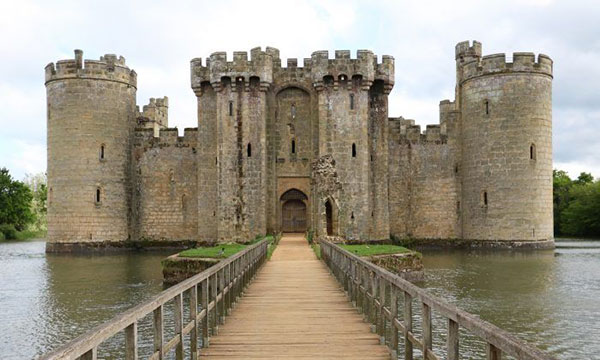
Medieval Architecture: Envisioning Cluny’s Legacy
Medieval architecture represents a fascinating chapter in architectural history, characterized by its grand structures and intricate designs that still inspire awe today. From the towering spires of cathedrals to the robust forms of monasteries like the famed Cluny Abbey, this era showcases the innovative construction techniques and artistic expression of its time. The legacy of medieval architecture can be seen in the way historical architecture continues to influence modern designs and methods. Today, advancements such as 3D modeling of medieval buildings and virtual reality in architecture allow enthusiasts and scholars alike to experience these magnificent feats of engineering as they were intended to be seen. Explore how the dedication of scholars like Kenneth Conant has helped us reconstruct the past and appreciate the monumental achievements of this remarkable period.
The term ‘Gothic structures’ often evokes images of the cathedrals that define the medieval skyline, showcasing a blend of aesthetic beauty and structural ingenuity. Simultaneously, the architectural remnants of the period, exemplified by notable sites such as the Cluny Abbey, highlight the spiritual and cultural significance ingrained within these edifices. As historians delve into the architectural evolution through various lenses—from sketches and blueprints to high-tech modeling—there emerges a rich tapestry of insights that reveal the complexities of construction and design. Terms like ‘historical buildings’ and ‘Romanesque artistry’ often accompany discussions of this era, illustrating how deep-rooted styles and techniques from the past continue to shape modern architectural narrative. By integrating contemporary methods, such as virtual reality applications, we can uncover the experience of medieval architecture like never before.
Reconstructing Cluny Abbey: A Journey Through Time
The reconstruction of Cluny Abbey, a monumental piece of medieval architecture, stands as an emblem of the intricacies involved in historical architecture. After its near-total destruction during the French Revolution, the abbey became the focal point of architectural historian Kenneth Conant’s extensive research. His work emphasized the importance of understanding the original form and aesthetics of significant historical buildings. This exploration not only highlights the historical value of Cluny Abbey but also illustrates a broader narrative about the methods and challenges in reconstructing the past.
The process of reconstructing Cluny Abbey is more than just physical restoration; it embodies a fascinating symbiosis of art and science. By employing modern technologies like 3D modeling and virtual reality, scholars and students are granted unprecedented opportunities to engage with the remnants of this once-grand structure. This project underlines the significance of historical architecture as a field, showcasing how contemporary methods breathe new life into the study of places like Cluny, integrating them with modern architectural techniques.
The Evolution of Architectural Representation
From the meticulous hand-drawings of the past to cutting-edge virtual reality experiences, the methods used to represent architectural history have evolved dramatically. These transformations allow historians and enthusiasts alike to appreciate the depth of architectural design, particularly in medieval settings. Cluny Abbey serves as a pivotal example of how architectural representation has changed over time, from detailed sketches and physical models to the interactive 3D modeling seen in current exhibitions.
Kenneth Conant’s approach in the early 20th century relied heavily on traditional techniques, emphasizing the importance of narrative and accuracy in representing medieval architecture. Today, students utilize advanced technologies such as 3D modeling, enabling them to visualize complex structures like Cluny Abbey in an immersive environment. This evolution reflects a broader trend within architectural history, where digital tools enhance our understanding and experience of historical buildings.
The Cluny Capitals: Mystery and Intrigue
The eight capitals discovered at Cluny Abbey present an enduring mystery that captivates scholars to this day. Each beautifully crafted capital is adorned with intricate designs that suggest a range of narratives, yet their exact significance remains elusive. This ambiguity invites ongoing investigation, as researchers debate the origins and interpretations of these medieval artworks, which serve as some of the earliest examples of figural sculpture from the Romanesque era.
The study of these capitals highlights the challenges historians face in unraveling the complexities of medieval architectural elements. Kenneth Conant initially believed these capitals told a coherent story about monastic life, yet over time, he recognized the fragmentation of their narratives. With modern technological advancements, including 3D modeling, the exploration of these capitals continues, offering fresh insights and understandings about the aesthetics and cultural contexts of medieval architecture.
Virtual Reality: Transforming Architectural Experiences
The intersection of virtual reality (VR) and architectural history has revolutionized how we explore and experience historical sites like Cluny Abbey. This technology allows users to immerse themselves in reconstructed versions of significant architectural landmarks, fostering an appreciation for their grandeur as they once appeared. Harvard’s exploration of Cluny Abbey through VR showcases how modern scholars can engage with history in unprecedented ways, breaking down the barriers of time and distance.
With VR, students can not only visualize but also interact with the architectural elements of sites like Cluny Abbey, experiencing the scale and details that would otherwise remain beyond reach. This technological advancement significantly enhances learning and engagement, as users can freely navigate through spaces that have been lost to history. By leveraging VR, architectural historians are forging new pathways in the study of medieval architecture, ensuring that the stories of structures like Cluny Abbey are preserved and appreciated by future generations.
3D Modeling: A Tool for Architectural Discovery
3D modeling has emerged as a pivotal tool in the field of architectural history, allowing for a detailed examination of structures like Cluny Abbey. By creating digital representations of the abbey’s remaining structures, historians and architects can analyze various elements from multiple angles, fostering a deeper understanding of its design and significance. This method not only aids in reconstructing what has been lost but also provides insights into the historical techniques employed in medieval architecture.
As contemporary architectural students engage with 3D models of Cluny Abbey, they learn to appreciate the complexities of its historical architecture. These models offer a unique opportunity to inspect the craftsmanship of the abbey’s capitals and other decorative elements, encouraging curiosity and exploration. Through this digital reinforcement of historical study, 3D modeling enhances the educational experience, bridging the gap between past and present in the realm of architectural history.
The Role of Technology in Architectural Education
Incorporating technology into architectural education has transformed the way students study historical architecture. Modern tools, including 3D modeling and virtual reality, not only enhance historical understanding but also facilitate a more interactive approach to learning about structures like Cluny Abbey. These advancements empower students to visualize and analyze architectural elements in a way that was previously impossible, directly connecting them to the discoveries of scholars like Kenneth Conant.
As architectural education continues to evolve, it leverages the benefits of technology, enabling a richer comprehension of architectural history. Institutions like Harvard stand at the forefront of this shift, employing innovative techniques to explore the narratives within historical architecture. By emphasizing the importance of adaptation and curiosity in this field, educators prepare future scholars for a landscape where technology and tradition coexist harmoniously.
The Historical Significance of Cluny Abbey
Cluny Abbey stands as a significant monument in the study of medieval architecture, representing one of the largest and most influential religious buildings of its time. Constructed between 1088 and the late 12th century, it played a crucial role in the development of monastic life in Europe. The abbey’s architectural grandeur and the innovations it introduced, such as the use of ribbed vaulting, have made it a focal point for architectural historians and students seeking to understand the direction of Western architectural practices during the Middle Ages.
The historical importance of Cluny Abbey extends beyond its physical structure. It symbolizes the power of the Benedictine order and its influence on European society during a pivotal period in history. In studying Cluny, we gain insights not just into architectural design, but also the cultural and sociopolitical climates of medieval Europe. The abbey’s legacy continues to inspire contemporary discussions surrounding historical architecture and the preservation of cultural heritage.
Understanding the Architectural Language of the Abbey
The architectural language of Cluny Abbey showcases a blend of styles and symbols characteristic of the Romanesque period. Each element of the abbey, from its large nave to the intricately designed capitals, has a story to tell, revealing the cultural and religious values of the time. Understanding this architectural vocabulary is crucial for appreciating the depth of meaning embedded within historical structures.
As scholars and students analyze the architectural features of Cluny, they embark on a journey of context and interpretation. Familiarity with the historical architecture vernacular allows for a deeper appreciation of the deliberate choices made by builders and architects. These architectural decisions reflect the societal aspirations of the medieval era, positioning Cluny Abbey as a testament to the enduring significance of architectural expression throughout history.
The Impact of Historical Architecture on Modern Design
The influence of historical architecture, particularly structures like Cluny Abbey, can still be felt in modern design practices. Elements such as symmetry, scale, and the use of natural materials drawn from historical architecture continue to inspire today’s architects. By examining the principles applied in constructing Cluny, contemporary designers can extract lessons that enrich their own creative processes.
Moreover, as modern architecture increasingly prioritizes sustainability and adaptability, the timeless lessons of historical structures become ever more relevant. The durability and functionality inherent in medieval architecture underscore the importance of designing spaces that not only meet current needs but also stand the test of time. As architects look back to iconic works like Cluny, they can foster a new architectural narrative that bridges the past with innovative futures.
Frequently Asked Questions
What is Cluny Abbey and its significance in medieval architecture?
Cluny Abbey, specifically Cluny III, was the largest church in medieval Europe, constructed in 1088 in Burgundy, France. It is significant in medieval architecture for its scale, intricate design, and as a pivotal influence in the development of Romanesque architecture. The abbey housed approximately 1,000 monks and served as a central figure in the monastic reform movement, showcasing the grandeur and complexities of historical architecture.
How has the study of medieval architecture evolved over time?
The study of medieval architecture has significantly evolved from hand-drawn sketches and physical site visits to the use of modern technologies like 3D modeling and virtual reality in architecture. Architectural historians, like Kenneth Conant, laid the groundwork for these advancements by applying detailed observation techniques and excavations that now integrate advanced digital tools for reconstructing buildings like Cluny Abbey.
What role does 3D modeling play in understanding historical architecture such as Cluny Abbey?
3D modeling plays a crucial role in understanding historical architecture like Cluny Abbey by allowing researchers and students to recreate and interact with structures that no longer exist. Using photogrammetry, historians can generate accurate digital representations of elements like the abbey’s capitals, enabling new insights and interpretations that were previously unimaginable.
How does virtual reality enhance the experience of medieval architecture studies?
Virtual reality enhances studies of medieval architecture by immersing users into reconstructed environments of significant buildings like Cluny Abbey. This technology allows scholars and students to experience the spatial and aesthetic qualities of these historical structures, providing a more profound understanding of architectural history and the intended atmosphere of medieval designs.
What techniques are used to reconstruct the designs of medieval buildings like Cluny Abbey?
Techniques for reconstructing medieval buildings like Cluny Abbey include detailed site excavations, historical documentation reviews, and advanced methods such as photogrammetry and 3D modeling. These approaches allow historians to project how structures originally appeared and to analyze their architectural features comprehensively, contributing to the body of knowledge in architectural history.
What mysteries still exist around the capitals found at Cluny Abbey?
The capitals found at Cluny Abbey remain a subject of mystery and intrigue in the study of medieval architecture. Scholars debate their artistic origins, meanings, and the stories they might convey about monastic life. With varying theories about their symbolism and design, they are considered one of the earliest examples of figural sculpture from the Romanesque era.
How do modern architectural historians analyze the works of previous scholars like Kenneth Conant?
Modern architectural historians analyze the works of scholars like Kenneth Conant by engaging with his detailed illustrations and reconstructions of buildings such as Cluny Abbey. Current techniques like 3D modeling and virtual reality allow for deeper insights into his methods and assumptions, making it possible to reassess historical constructs with modern perspectives on architectural history.
| Key Points |
|---|
| Cluny III was the largest building in Europe, constructed in 1088 and demolished during the French Revolution. |
| Kenneth Conant, an architectural historian, aimed to reconstruct the abbey from its ruins; his work included precise illustrations based on knowledge and excavations. |
| The exhibition at Harvard showcases the evolution of studying medieval architecture, leveraging modern technologies like 3D modeling and virtual reality. |
| The Cluny capitals, discovered and analyzed by Conant, are believed to tell a story of virtues in monastic life but remain shrouded in mystery. |
| Today’s architectural historians use digital tools for analysis, allowing a deeper understanding and interaction with historical architectural forms. |
Summary
Medieval architecture represents a fascinating and complex field of study, exemplified by the enduring legacy of structures like Cluny III. This architectural marvel showcases not only the grandeur of its time but also the passionate efforts of scholars like Kenneth Conant to restore its memory through reconstruction. Modern advancements in technology now allow us to explore and understand medieval architecture in ways that past generations could only dream of, making it an exciting era for both historians and enthusiasts alike.


